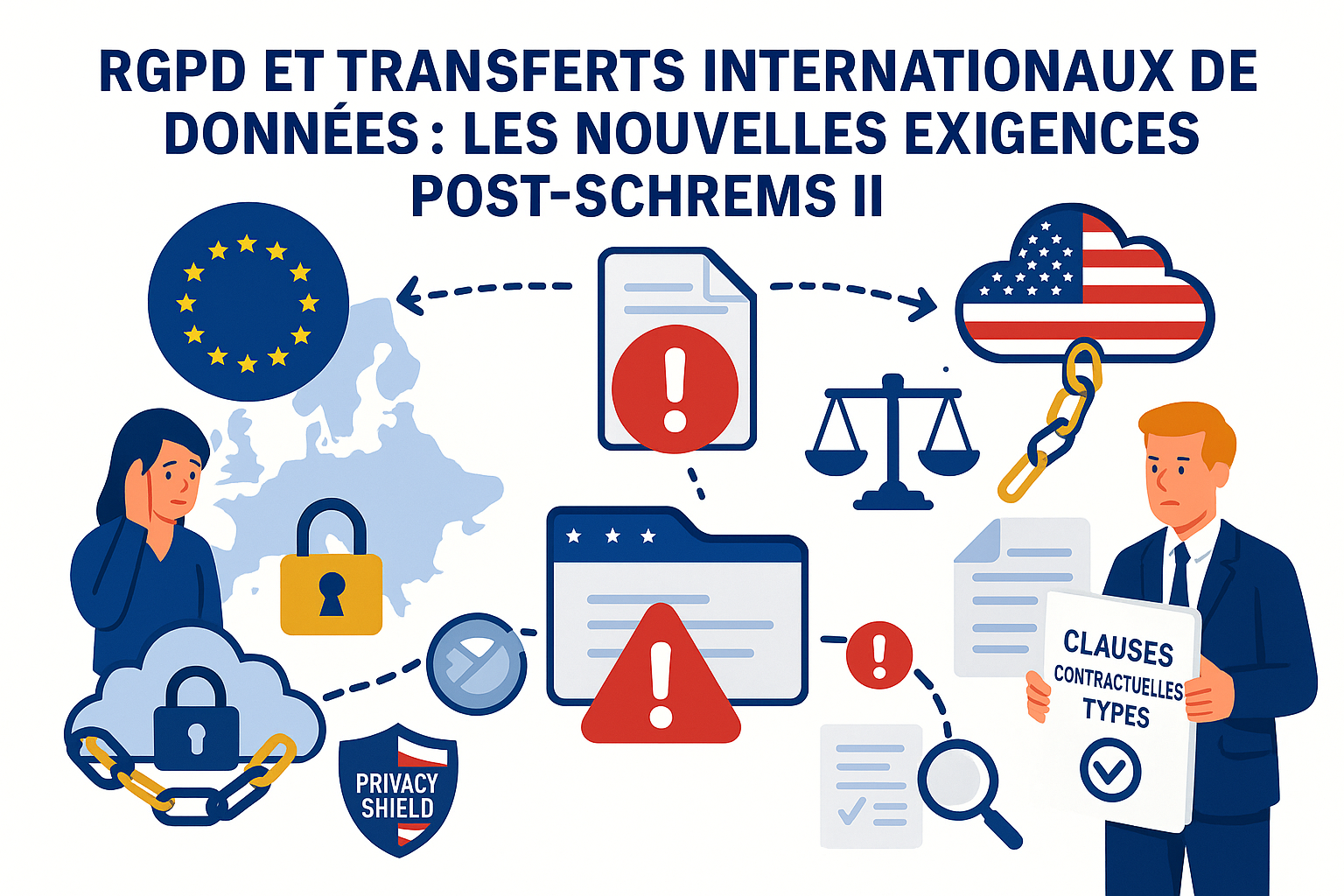In a world where data sharing has become a daily necessity for businesses, the legal framework surrounding international transfers of personal data has never been more complex.
Since the "Schrems II" ruling by the Court of Justice of the European Union in July 2020, European organizations face tougher requirements for any transfer of personal data outside the European Economic Area (EEA).
This article outlines the major implications of this decision and solutions for keeping your data flows compliant.
If you need a RGPD lawyer, contact me!
The major impact of the Schrems II ruling
The Schrems II decision has fundamentally challenged corporate practices by invalidating the Privacy Shield, the mechanism that until then facilitated data transfers to the United States. This invalidation is based on a clear finding: once transferred across the Atlantic, European citizens' data does not benefit from protection equivalent to that guaranteed by the RGPD, particularly in the face of US government surveillance programs.
This landmark decision is not limited to exchanges with the United States. It now requires a rigorous assessment of the level of data protection in any third country before personal information is transferred there. For European companies, this represents a real paradigm shift, requiring a complete overhaul of their data management strategy.
Authorized transfer mechanisms post-Schrems II
Despite this restrictive context, there are several legal solutions that can help you maintain the data flows you need to run your business. The main mechanism remains the use of the Standard Contractual Clauses (SCC ) published by the European Commission. These clauses, updated in June 2021 to take account of post-Schrems II requirements, constitute a standardized contract between the exporter and importer of data.
Binding Corporate Rules (BCR) represent a solid alternative for multinational groups. These internal rules, approved by the data protection authorities, govern all transfers within the same group of companies, offering a global, harmonized solution.
In certain specific cases, transfers may also rely on derogations provided for in Article 49 of the GDPR, such as the explicit consent of the data subject or the need to perform a contract. However, the interpretation of these derogations remains strict and their use must remain exceptional.
Essential complementary measures
The use of the legal mechanisms mentioned above is no longer sufficient. One of the main innovations post-Schrems II is the obligation to implement additional measures when the legal framework of the recipient country does not guarantee adequate protection.
These additional measures may be technical in nature, such as end-to-end data encryption with keys kept in the EEA, advanced pseudonymization of information, or decentralized storage solutions. They can also be contractual, with the addition of clauses reinforcing the importer's obligations, notably in terms of transparency regarding governmental access requests.
Implementing these measures requires an in-depth analysis of the risks specific to each data flow and each recipient country. The legal complexity of international transfers now requires the expertise of an RGPD lawyer to secure your data exchanges and avoid significant sanctions. Legal support not only helps to identify the risks specific to your situation, but also to determine the most appropriate additional measures.
Transfer evaluation: an ongoing obligation
Compliance with international transfers is not a one-off process, but an ongoing obligation. Every organization exporting data must now document a Transfer Impact Assessment (TIA) for every data flow leaving the EEA.
In particular, this assessment must analyze :
- The context of the transfer (nature of the data, purposes, etc.)
- The laws and practices of the destination country, particularly with regard to government access
- Theeffectiveness of protectionmeasures implemented
The documentation of this analysis is of crucial importance in the event of an inspection by the data protection authorities, as it demonstrates your proactive compliance approach. The ability to produce rigorous, regularly updated assessments is a decisive factor in the event of an investigation.
Preparing for the future of international transfers
The framework for international transfers continues to evolve rapidly. New solutions are emerging, such as Privacy Shield 2.0 (now called EU-US Data Privacy Framework), which attempts to provide stronger guarantees for transfers to the United States.
At the same time, initiatives are underway to promoteinteroperability between different data protection systems around the world. The OECD, in particular, is developing common principles that could facilitate international exchanges while maintaining a high level of protection.
Companies today need to adopt a strategic approach to data transfers, integrating compliance right from the design stage of their information flows. This " privacy by design " approach applied to international transfers not only reduces legal risks, but also boosts the confidence of partners and customers.
Towards European digital sovereignty
Changes in the legal framework for data transfers reflect a fundamental trend: the assertion of European digital sovereignty. This dynamic is prompting many organizations to rethink their data hosting and processing strategies.
More and more companies are choosing to localize their data within the European Union, limiting international transfers to situations that are strictly necessary. This approach, while sometimes more costly in the short term, offers appreciable legal certainty and anticipates likely changes in regulations.
Cette tendance s’accompagne du développement d’offres cloud souveraines européennes, proposant des garanties renforcées en termes d’indépendance vis-à-vis des législations extraterritoriales comme le Cloud Act américain. L’accompagnement d’un avocat spécialisé en droit des logiciels et des bases de données est précieux pour sécuriser ces infrastructures de stockage.
International transfers are undoubtedly one of the most complex aspects of the RGPD, requiring constant legal monitoring and regular adaptation of practices. In this shifting context, having expert legal support becomes a real competitive advantage.
Act now to avoid tomorrow's sanctions
Faced with this growing complexity, organizations must act without delay to bring their international transfers into line. European data protection authorities have made transfers a priority in their control activities, as demonstrated by the recent sanctions imposed on several major companies.
These sanctions, which can amount to up to 4% of annual worldwide sales, are often accompanied by injunctions to cease certain transfers, with potentially devastating impacts on day-to-day operations. In addition to financial penalties, non-compliance in this area can threaten business continuity.
La gestion des transferts internationaux requiert aujourd’hui une expertise juridique pointue et une compréhension fine des enjeux techniques. Pour naviguer dans cet environnement complexe, les organisations gagnent à s’entourer de spécialistes capables d’élaborer des solutions sur mesure et pérennes. Un avocat spécialisé CNIL et un expert en droit internet peuvent vous accompagner dans cette démarche.
Data protection has become a strategic issue that goes far beyond mere regulatory compliance. Companies that know how to turn this constraint into an opportunity, by making data protection a real differentiating argument, will have a significant competitive advantage in a world where digital trust is becoming a cardinal value.




